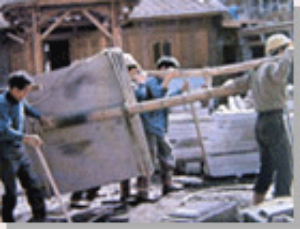▌Technique for Construction
There is a long history for the development of the traditional Chinese garden. The theory of scene construction has been formed for years. The technique of scene construction is used to create views with depth and gradation to bring happiness to one’s mind and to enlighten one’s thought.

▌A better and better view
A visit to the Traditional Chinese Garden is compared to listening to a marvelous music from its beginning to the end. There is a settled order for appreciation, so that people can be identified with the integrative effect that the garden designer wants to create. The route for visiting the Ben-Yuan Lin’s Family Abode and Garden is as follows. While visiting, you will first see the simple Ji-Gu Library, followed by the graceful and peaceful Fang-Jian Study and then the most luxurious Lai-ching Hall. By and by, you will be conscious of the wonders created by the gardening designers and the craftsmen. For example, from Ji-Gu Library to Fang-Jian Study, you have to pass through a dark and quiet corridor path. Suddenly, you see a brilliant pond in front of you. The pond opens your eyes and surprises you just as a Chinese poem describes “In the end of the mountain road, it seems that there is no way out. Out of the darkness, you see again villages and beautiful flowers.”

▌See Large in Small
Compared with the tremendous mountains and waters in the nature, those in the family garden seem relatively mini and cute. How can you not only enjoy the views in the limited space but also have a strong sense of the infinitive universe at the same time? To make it, the gardening designer uses the techniques, such as comparison and setting of contrast. With the contrast of large and small, far and near, bright and dark, the visitors may have the illusion that the space is wide.

▌View Changes with the Different Position
In the traditional Chinese gardens, the touring route is crooked with different altitudes. Corridors, walls, and bridges are also used to lead people to go forward, so the views in the visitors’ eyes are not horizontal. Along the touring paths, the garden designer uses mountains, waters, buildings, flowers, and trees to compose attractive scenes and to impress visitors little by little.
▌Variety and Unity
The Ben-Yuan Lin’s Family Abode and Garden is a place for the Lin Family to pursue the spiritual life and to host officials and rich businessmen. There are various and different facilities inside the garden with distinctive functions but clear orders which can be united as a whole as well.
The whole place is divided into four sections. The first is the studies, Ji-Gu Library and Fang-Jian Study. The second is Lai-Ching Hall and it is used for honorable guests to take a rest, for gathering and, for meeting. The theater pavilion, Kai-Shuan-Yi-Shiau and Shiang-Yu Rela, a place to see flowers, are its subsidiaries. The third is Ding-Jing Hall where the party takes place. Yue-Po-Terrace is its subsidiary. The fourth is Guan-Jia Hall and Banyan Shade Pond.
This garden design puts much emphasis on the delicate arrangement. It offers abundant and colorful images to the buildings. You can find more than thirty kinds of flower-shaped windows. Each has its own specialty, but is also in accordance with the sights. The system of wood brackets on the top of a column that supports the crossbeam in the Chinese wood architecture has various forms like dragon-tigers. While some dragon-tigers are cute and interesting, others are brave and proud. Some are built into the shape of knife of Kuan-kong (a hero in Chinese culture) or “Ru-Yi” (An ornament means good luck in Chinese culture). These changes integrated with the building surprise the visitors wherever they go by and attract them.
▌No the Distances- Borrowed Scenery
The ancient gardening designer, Ji Cheng once said “There is no distance between the borrowed scenery.” This means that the mountain and water scenery of the nature, the famous temple and the pavilion shadow can be borrowed and integrated with the buildings in the garden as part of the scenes inside. If you go up to Lai-Ching Hall and Guan-Jia Hall, in the northward you can see Dan-Shui River and Kauan-Yin Mountain nearby, and you can appreciate the view in the garden. And at a distance, you can see farmers work hard in their land. This composes a unique scene. However, with the urban development and the population explosion nowadays, it’s very difficult to borrow good views from the nature outside the walls to the traditional family garden.

▌Design of the Pairs of Scenes
The pairs of scenery in the garden can be comparative and relative in the eyes of the visitors. People can enjoy the view on the spot and the spot itself can be viewed as well.
▌Mark the Scenery as a Painting
Sometimes through the window of the building, you will find scenery with good painting frames. It is the techniques of marking the scenery. The doors, windows, or the space between two columns are used to form a frame, so the beautiful scenery is marked in it as a painting.
▌Application of the Obstacle for View
In the traditional Chinese gardens, the designer doesn’t allow the visitor to view all at the same time on purpose. If the visitor can see the whole garden at the first sight, there is no interest at all. Therefore, the proper use of the obstacles for views becomes the marvelous idea of the garden designer.